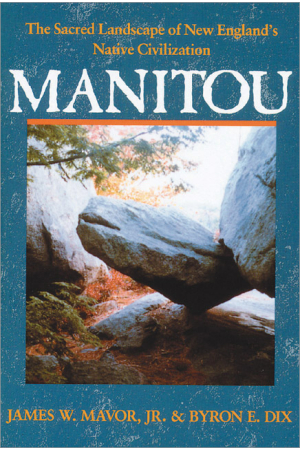Manitou
The Sacred Landscape of New England's Native Civilization
By (Author) James W. Mavor, Jr.
By (Author) Byron E. Dix
Availability:
In Stock
- Pages: 400
- Book Size: 6.75 x 10
- ISBN-13: 9780892810789
- Imprint: Inner Traditions
- On Sale Date: November 1, 1989
- Format: Paperback Book
- Illustrations: 300 b&w illustrations
Coauthors Mavor and Dix tell the fascinating story of the discovery of what is believed to be ancient Native American ritual sites and the exploration of these many stone structures and standing stones, whose placement in the surrounding landscape suggests that they played an important role in celestial observation and shamanic ritual.
In the summer of 1974 Byron Dix discovered in Vermont the first of many areas in New England believed to be ancient Native American ritual sites. Dix and coauthor James Mavor tell the fascinating story of the discovery and exploration of these many stone structures and standing stones, whose placement in the surrounding landscape suggests that they played an important role in celestial observation and shamanic ritual.
Manitou
The Sacred Landscape of New England's Native Civilization
Acknowledgments
Prologue
1. First Discovery in Vermont
2. A Pleiades and Sun Sanctuary at the Source of Waters
3. Stone Mounds in Massasoit's Domain
4. Native American Traditions of Stone and Earthworks
5. Land and Sky
6. Indian Meet the Jesuits, Pilgrims, Puritans and Quakers
7. The Eighteenth Century
8. Shakers and Shamanistic Christianity
9. Traditions of Stoneworks in North America, Europe and the Arctic
10. Earthquakes and Vision Quests in the Land of the Mohegans
11. Nashoba
12. Back to Calendar One
13. Manitou
Notes
Index
James Mavor was an oceanographic engineer at the Woods Hole Oceanographic Institute. He was one of the designers of the deep submersible Alvin, and he initiated the Minoan excavations on Thera, which culminated in the publication of Voyage to Atlantis. Byron Dix, now deceased, was an optical designer. For fifteen years they worked together researching New England anthropology and archaeo-astronomy.
". . . among the few innovative advances in the field of New England archaeology in recent years . . . looks at a class of data which are ordinarily overlooked by both prehistorians and historians, and begins to fit them into a new paradigm . . . sensitively written and generally well-supported by documentary and excavational evidence."
Massachusettes Archaeological Society
"Through this work we see our landscape anew. Now when we go to the woods, where before we saw just low walls, we have learned to see stone mounds and marked trees, vigil places, pointer, marker, and god stones. Walking there has come to be an honoring of a time when all life was holy."
Nancy Jack Todd, Annals of the Earth
"This ground-breaking treatment, handsomely illustrated with photos, maps, and line drawings, will unquestionably propel the emerging field of American geomancy considerably forward. A contemplation of the manitou worldview, presented here with excellence and mature excitement, yields a radically different appraisal of a fundamental aspect of our national history and geography, while suggesting new land use and conservation parameters for the future."
Yoga Journal
Massachusettes Archaeological Society
"Through this work we see our landscape anew. Now when we go to the woods, where before we saw just low walls, we have learned to see stone mounds and marked trees, vigil places, pointer, marker, and god stones. Walking there has come to be an honoring of a time when all life was holy."
Nancy Jack Todd, Annals of the Earth
"This ground-breaking treatment, handsomely illustrated with photos, maps, and line drawings, will unquestionably propel the emerging field of American geomancy considerably forward. A contemplation of the manitou worldview, presented here with excellence and mature excitement, yields a radically different appraisal of a fundamental aspect of our national history and geography, while suggesting new land use and conservation parameters for the future."
Yoga Journal







